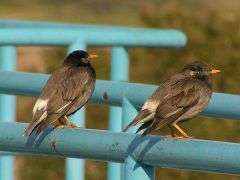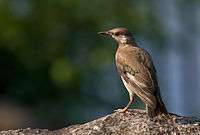White-cheeked starling
| White-cheeked starling | |
|---|---|
 | |
| Adult male (left) and female | |
| Scientific classification | |
| Kingdom: | Animalia |
| Phylum: | Chordata |
| Class: | Aves |
| Order: | Passeriformes |
| Family: | Sturnidae |
| Genus: | Spodiopsar |
| Species: | S. cineraceus |
| Binomial name | |
| Spodiopsar cineraceus Temminck, 1835 | |
| Synonyms | |
|
Sturnus cineraceus | |
The white-cheeked starling or grey starling (Spodiopsar cineraceus) is a passerine bird of the starling family. It is native to eastern Asia where it is a common and well-known bird in much of its range. Usually, it is placed in the genus Spodiopsar.
Description

White-cheeked starlings are 24 cm in length. The adult male is mainly dark grey-brown with a paler belly and a whitish band across the rump. The head is blackish with whitish cheeks and forehead. There is a white border to the tail and white markings on the secondary wing feathers. The legs are pale orange and the bill is orange with a black tip. Adult females are similar to the males but paler and duller.
The juvenile is brown with pale cheeks and rump and no black tip to the bill.
The loud, monotonous call is a series of harsh, creaking notes.
Distribution and ecology

The breeding range covers central and north-east China, Korea, Japan and south-east Siberia. In winter birds from colder regions migrate south to southern and eastern China, South Korea, southern Japan, Taiwan and northern Vietnam with vagrants reaching the Philippines, Thailand and Myanmar. There is a record from Homer, Alaska in 1998 which probably arrived with a ship (West 2002).
It inhabits woodland, farmland, and open country and has also adapted to parks and gardens in urban areas. It is most common in lowland areas (usually below 700m in Japan).
It has a varied diet which includes fruit and insects such as mole crickets.
The breeding season lasts from March to July and often two clutches of eggs are laid during that time. The nest is built in a hole in a tree or building or in a nestbox. Four to nine eggs are laid and are incubated for 14 to 15 days. The young birds fledge 13 to 15 days after hatching.
References
- ↑ BirdLife International (2012). "Sturnus cineraceus". IUCN Red List of Threatened Species. Version 2013.2. International Union for Conservation of Nature. Retrieved 26 November 2013.
- ↑ Sato, Shigeho; Kimura, Hiroshi; Hirata, Sachi; Yoshiaki, Okai. "A record of interspecific hybridization of the Grey Starling Sturnus cineraceus and the Red-billed Starling Sturnus sericeus in Sukumo, Kochi Prefecture". J-STAGE. Japanese Journal of Orinthology. Retrieved 17 August 2015.
Sources
| Wikispecies has information related to: Sturnus cineraceus |
| Wikimedia Commons has media related to Sturnus cineraceus. |
- Brazil, Mark A. & Yabuuchi, Masayuki (1991): The Birds of Japan. Christopher Helm, London. ISBN 1-56098-030-3
- Jønsson, Knud A. & Fjeldså, Jon (2006): A phylogenetic supertree of oscine passerine birds (Aves: Passeri). Zool. Scripta 35(2): 149–186. doi:10.1111/j.1463-6409.2006.00221.x (HTML abstract)
- MacKinnon, John Ramsay, Phillipps, Karen & He, Fen-qi (2000): A Field Guide to the Birds of China. Oxford University Press. ISBN 0-19-854940-7
- Robson, Craig(2002): A guide to the birds of Southeast Asia: Thailand, Peninsular Malaysia, Singapore, Myanmar, Laos, Vietnam, Cambodia. New Holland, London. ISBN 1-85368-313-2
- West, George C. (2002): A Birder's Guide to Alaska. American Birding Association. ISBN 1-878788-19-1
- Zuccon, Dario; Cibois, Anne; Pasquet, Eric & Ericson, Per G.P. (2006): Nuclear and mitochondrial sequence data reveal the major lineages of starlings, mynas and related taxa. Molecular Phylogenetics and Evolution 41(2): 333-344. doi:10.1016/j.ympev.2006.05.007 PMID 16806992 (HTML abstract)
